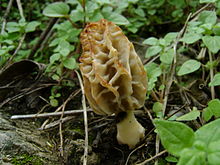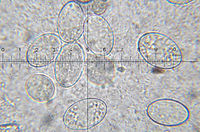Morchella rufobrunnea
| Morchella rufobrunnea | |
|---|---|

| |
| Scientific classification | |
| Domain: | Eukaryota |
| Kingdom: | Fungi |
| Division: | Ascomycota |
| Class: | Pezizomycetes |
| Order: | Pezizales |
| Family: | Morchellaceae |
| Genus: | Morchella |
| Species: | M. rufobrunnea
|
| Binomial name | |
| Morchella rufobrunnea Guzmán & F.Tapia (1998)
| |
| Morchella rufobrunnea | |
|---|---|
| Smooth hymenium | |
| Cap is conical or ovate | |
| Stipe is bare | |
| Spore print is cream to yellow | |
| Ecology is saprotrophic | |
| Edibility is choice | |
Morchella rufobrunnea, commonly known as the blushing morel, is a
M. rufobrunnea grows in disturbed soil or in
Taxonomy and phylogeny
The first scientifically
The
Description
In
Morchella rubobrunnea is an edible fungus;[18] it has been described variously as "one of the tastiest members of the morel family",[12] and alternately as "bland in comparison to other morel species".[19] Individual specimens over 1 pound (0.45 kg) have been reported.[12]
Similar species
Morchella anatolica is the sister-species of M. rufobrunnea and rather similar in appearance, but produces smaller and slender fruit bodies with very few or no transverse interconnecting ridges. Microscopically, both species have longitudinally grooved ascospores when viewed under a scanning electron microscope or in the appropriate staining medium, but the spores of M. anatolica are generally larger on average, measuring (22.5–)24–27(–32) by (12–)13–17(–20) μm. M. anatolica also has larger and differently shaped terminal hyphae ("hairs") on the stipe, frequently exceeding 100–200 μm.[10]
Habitat and distribution
A predominantly
In the American continent, Morchella rufobrunnea ranges from Mexico through California and Oregon.[2] It has been hypothesised to have been introduced to central Michigan from California[5] and is one of seven Morchella species that have been recorded in Mexico.[1] In 2009, Israeli researchers used molecular genetics to confirm the identity of the species in northern Israel, where it was found growing in gravelly disturbed soil near a newly paved path at the edge of a grove. This was the first documented appearance of the fungus outside the American continent. Unlike North American populations that typically fruit for only a few weeks in spring, the Israeli populations have a long-season ecotype, fruiting from early November to late May (winter and spring). This period corresponds to the rainy season in Israel (October to May), with low to moderate temperatures ranging from 15–28 °C (59–82 °F) during the day and 5–15 °C (41–59 °F) at night.[21]
In
Cultivation

Morchella rufobrunnea is the morel that is
The fruit bodies of Morchella rufobrunnea have been cultivated under controlled conditions in laboratory-scale experiments. Primordia, which are tiny nodules from which fruit bodies develop, appeared two to four weeks after the first watering of pre-grown sclerotia incubated at a temperature of 16 to 22 °C (61 to 72 °F) and 90% humidity. Mature fruit bodies grew to 7 to 15 cm (3 to 6 in) long.[26]
The early stages of fruit body development can be divided into four discrete stages. In the first, disk-shaped knots measuring 0.5–1.5 mm (0.02–0.06 in) appear on the surface of the
References
- ^ JSTOR 3761230. Archived from the originalon 2015-09-23. Retrieved 2013-03-12.
- ^ a b Kuo M. (2008). "Morchella tomentosa, a new species from western North America, and notes on M. rufobrunnea" (PDF). Mycotaxon. 105: 441–6.
- ^ ISBN 978-0-89815-169-5.
- ^ ISBN 978-0-472-03036-1.
- ^ S2CID 45219627.
- PMID 20888422.
- S2CID 1394087.
- ISBN 978-1-57808-723-5.
- S2CID 207685509.
- ^ S2CID 232298567.
- PMID 22503770.
- ^ ISBN 978-1-77151-003-5.
- ^ Pilz D, McLain R, Alexander S, Villarreal-Ruiz L, Berch S, Wurtz TL, Parks CG, McFarlane E, Baker B, Molina R, Smith JE (2007). Ecology and Management of Morels Harvested From the Forests of Western North America. General Technical Report PNW-GTR-710 (PDF) (Report). Portland, Oregon: United States Department of Agriculture, Forest Service, Pacific Northwest Research Station. p. 4.
- ^ OCLC 797915861.
- ^ a b Clowez P, Bellanger JM, Romero L, Moreau PA (2015). "Morchella palazonii sp. nov. (Ascomycota, Pezizales): une nouvelle morille méditerranéenne. Clé des Morchella sect. Morchella en Europe". Documents Mycologigues. XXXVI: 71–84.
- ^ Clowez P, Alvarado P, Becerra M, Bilbao T, Moreau PA (2014). "Morchella fluvialis sp. nov. (Ascomycota, Pezizales): A new but widespread morel in Spain". Boletín de la Sociedad Micológica de Madrid. 38 (2): 251–260.
- ^ S2CID 16132175.
- ^ ISBN 978-0-520-95360-4.
- ISBN 978-1-60961-987-9.
- ^ Wood M, Stevens F. "California Fungi—Morchella rufobrunnea". MykoWeb. Retrieved 2014-03-29.
- ISSN 1534-2581.
- S2CID 15163613.
- ^ a b US patent 4594809, Ower, Ronald D.; Mills, Gary L. & Malachowski, James A., "Cultivation of Morchella", published 17 June 1986, assigned to Neogen Corporation
- ^ US patent 4757640, Ower, Ronald D.; Mills, Gary L. & Malachowski, James A., "Cultivation of Morchella", published 19 July 1988, assigned to Neogen Corporation
- ISBN 978-1-58008-175-7.
- S2CID 9872942.
- PMID 15912939.


